
Hi Gang…
Egads! How many American specials with American motive power could have been built in the ‘40s? And outside this country?
World War II had just ended in ’45, and here it was 2 years later and an American Ford-based special was being built in Europe – that’s pretty impressive gang! And it’s not far from a theme we’ve seen before in the early postwar years, as follows:
- Spohn Coachworks: Building American Sport Customs and sports cars for (mostly) returning GI’s from Europe from Ravensburg, Germany.
- DM Nacional: Building American sports customs and sport cars from Mexico City with Mark Wallach as principal designer
And now..
- Gatford / Gatso Coachworks: Sports and Competition Cars being built in Holland
Wow!
Why Talk About Gatford / Gatso Sports Cars?
The rationale for this story is simple – in the immediate postwar era, people across the world were bursting forth and bringing sports cars and “sport custom” cars of their own design to fruition – and many of these in the postwar era utilized Ford Flatheads as their power. Even this one from Gatford, later renamed Gatso, was Ford based in power and aluminum in skin.
The first postwar car out of the pocket for Gatford was the sports roadster – the car we’re covering today. Their second car is one we’ll cover in a future story and had an airplane canopy type bubble top. When you add that feature to the headlight positioned in the center of the hood, it rises to the top of my list of cars to find.
If only the Gatford / Gatso sports cars came to America! What a car that would be to find. Finally….a car that would give any “Spohn” Sport Custom a run for its money in being outrageous….at least in some ways.
And no doubt Gatford / Gatso cars were exceptionally built – just like the Spohn cousins were in Germany.
Let’s see what the Gatford brochure says about their cars in late 1947.
Gatford Brochure: December 1947
Two models available: The “Sports Roadster” an open two-seater (a third seat available at extra cost) with folding hood. The “Aero Coupe,” with sliding transparent top. This model is designed to meet the requirements of those who desire a fast closed car with a high degree of comfort for two persons and equally comfortable seating for two passengers on occasion. The top can be removed in a few seconds.
| Gatford | |||
| Sports and Competition Cars | |||
| The GATFORD is a fast, comfortable and above all a reliable Sportscar, designed to be driven for a long time at high average speeds. By means of a dual ratio back axle the revolutions of the engine can be kept quite low, which improves its durability considerably while a low petrol consumption is obtained. The car itself is chiefly built from Ford parts, which are obtainable everywhere at reasonable cost. The very light body is built of duraluminium attached to a rigid steel frame. As a result of years of experience gained in all kinds of international competitions, a very good road holding has been obtained, coupled with remarkable good steering. The driving qualities are only equaled by those of a few high priced European cars. | |||
|
Specifications |
|||
| Engine: | 120 b.h.p. at 4000 r.p.m. V8 monobloc. Side valves. Aluminium high-compression heads with polished combustion chambers. Two down-draught twin-choke carburettors. Special intake manifold, highly polished. Steel backed main and connecting rod bearings. Full flow oil filter and cooler. Special design camshaft. Bore and stroke 3.187 x 3.75 ins (80.95 x 95.25 mm). Cubic capacity : 239 cub. ins (3917 cc). V8, O.H.V. engine of 175 b.h.p. at 5200 r.p.m. available at extra cost. |
||
| Cooling system: | Pressure radiator. Two waterpumps and a crankshaft-mounted fan. | ||
| Ignition: | Scintilla Vertex magneto. Lodge H.N.P. 14 mm. plugs. | ||
| Clutch: | Single dry plate. | ||
| Gear ratios: | top | 1 : 1 synchromesh | |
| second | 1.8 : 1 synchromesh | ||
| first | 3.2 : 1 | ||
| reverse | 4.0 : 1 | ||
|
|||
| Suspension: | Transverse leaf springs (front and rear) with “Silentbloc” bushes. Anti-roll bar and double acting hydraulic shockabsorbers in front. Hydraulic stabiliser with double acting shockabsorbers at rear. | ||
| Brakes: | Girling Hydro-Mech. | ||
| Steering: | Left or right hand optional. Two-spoke 17″ (455 mm) diam. steeringwheel. | ||
| Wheels: | 5 Easy-clean steel discs. Second spare wheel complete with tire at extra cost. | ||
| Tires: | 6.00 x 16, 6-ply. | ||
| Petrol Tank: | At rear, 20 Imp. gallons (90 L) capacity. Two spare tanks, contents 7 Imp. gallons (30 L) each, mounted in centre, alongside chassismembers, at extra cost. | ||
| Electrical equipment: | 6 Volt air ventilated dynamo. Constant voltage control. 100 Amp. hrs. battery. Two powerful broad-beam headlamps and one long-beam centre lamp. Rheostatic controlled instrument lights. | ||
| Dimensions: | Wheelbase: 108¼ ins (2.75 m). | ||
| Track, front: 56 ins (1.42 m). | |||
| Track, rear: 58 ins (1.47 m). | |||
| Overall length: | 171 ins (4.35 m). | ||
| Overall width: | 66 ins (1.70 m). | ||
| Overall height: | 53 ins (1.35 m). | “Sports Roadster” | |
| 57 ins (1.45 m). | “Aero Coupé” | ||
| Ground clearance: | 8 ins (0.20 m). | ||
| Turning circle: | 36 ft (5.47 m). | ||
| Weight: | 21.5 cwt (1100 kg). | “Sports Roadster” | |
| 23.5 cwt (1200 kg). | “Aero Coupé” | ||
| Specifications and prices may have to be modified without notice December 1947 | |||
——
Gatford / Gatso: The Cars
Thanks to the help of Ben Uijtenhaak of the Netherlands, we have additional detail on this car and other Gatford / Gatso sports cars. Here’s what Ben had to say on his website about this specific car:
Built on the chassis of the Ford V8 Roadster in which Maurice Gatsonides and Klaas Barendregt had completed the 1938 Liège-Rome- Liège Rally in 2nd position overall and winner of the unmodified category. The chassis was suitably modified to reduce height.
The standard Roadster’s 3.6 litre V8 S.V. engine was retained at first, but replaced by the larger Ford Mercury 4 litre V8 soon after completion. The same type used in subsequent Gatsonides-built cars. For the Gatford the Mercury engine’s power output was raised from the normal 95 b.h.p. to a figure of 124.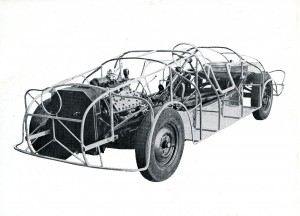
This was achieved principally by using a pair of American tuning expert Eddy Edmunds’ dual carburetors manifold and ribbed aluminium cylinder heads. Of more efficient design, these raised the compression ratio from the normal 6.8 : 1 to 7.5 : 1.
Transmitting the power to the rear wheels was the old Ford Roadster’s normal three-speed gearbox and a Columbia two-speed rear-axle assembly. Thus, the Gatford had the benefit of six forward speeds. Overall the Gatford could be considered as a Gatso modified Ford.
Perhaps the most striking feature however was the third head-light placed centrally above the radiator grille. This had come about due to the need for an extremely low bonnet line at the front of the car, whilst further back needing to clear the carburetors mounted in the V of the V8 engine.
Finished in second place overall on the first postwar staging of the Alpine Rally, July 1946. Team : Maurice Gatsonides – Henk Blijdenstein. Finished in third place in the Lisbon Rally 1947. Team : Maurice Gatsonides – Theo van Ellinkhuizen.
Finished first on the first, postwar, Dutch sportscar race at the Leeuwarden air force base, July 1947. Driver : Maurice Gatsonides. This car was the only one to carry the “Gatford” name script, as the Ford Motor Company felt it sounded too much like “Matford” (the abbreviation of Mathis-Ford), which was Ford’s brandname in France.
Consequently the remainder of the Heemstede-produced cars bore the name “Gatso” which was of course every bit as appropriate, although, ironically, those later cars were actually built on genuine but lowered Matford “13” (Ford France) chassis with 4″ shorter wheelbase than the American one.
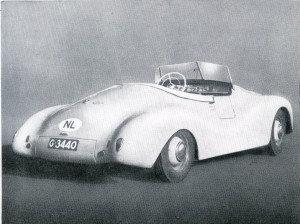 Click here to visit Ben’s website for additional information about these cars.
Click here to visit Ben’s website for additional information about these cars.
Summary:
The history and heritage of our favorite fiberglass sports cars of the ‘50s starts with the history and heritage of sports cars of the 40’s and early 50s across the world.
The “Gatford” being a Ford powered product is of great interest even though it may not have influenced the designs and builds in America.
Rather, it represents parallel thinking and development “across the pond” using the same approach many of the American specials utilized at the same and later time.
And how cool is that third headlight and canopy!
Thanks again to Ben Uijtenhaak for his assistance in understanding these cars and history in greater detail and for making his Gatford / Gatso web page for all to enjoy.
Hope you enjoyed the story, and until next time…
Glass on gang…
Geoff
——————————————————————-
Click on the Images Below to View Larger Pictures
——————————————————————-
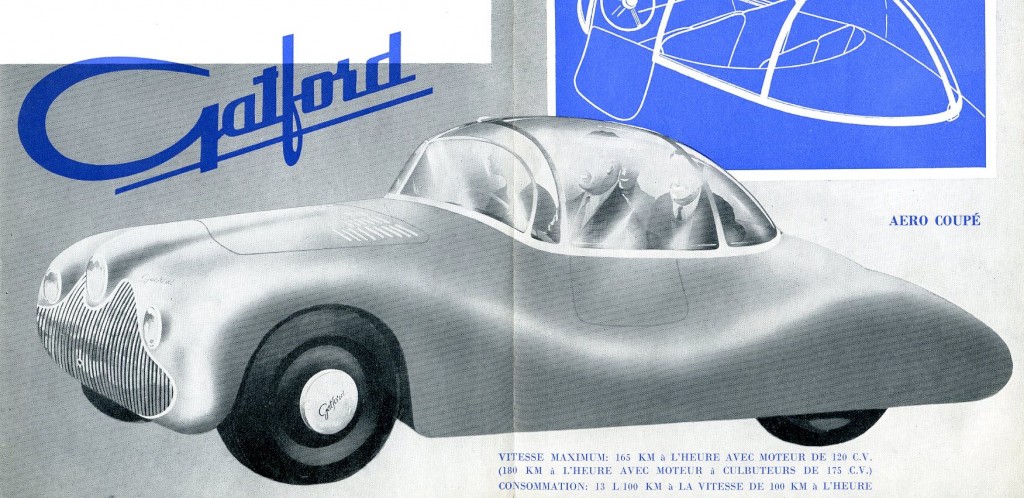
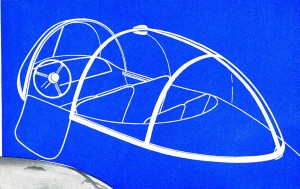
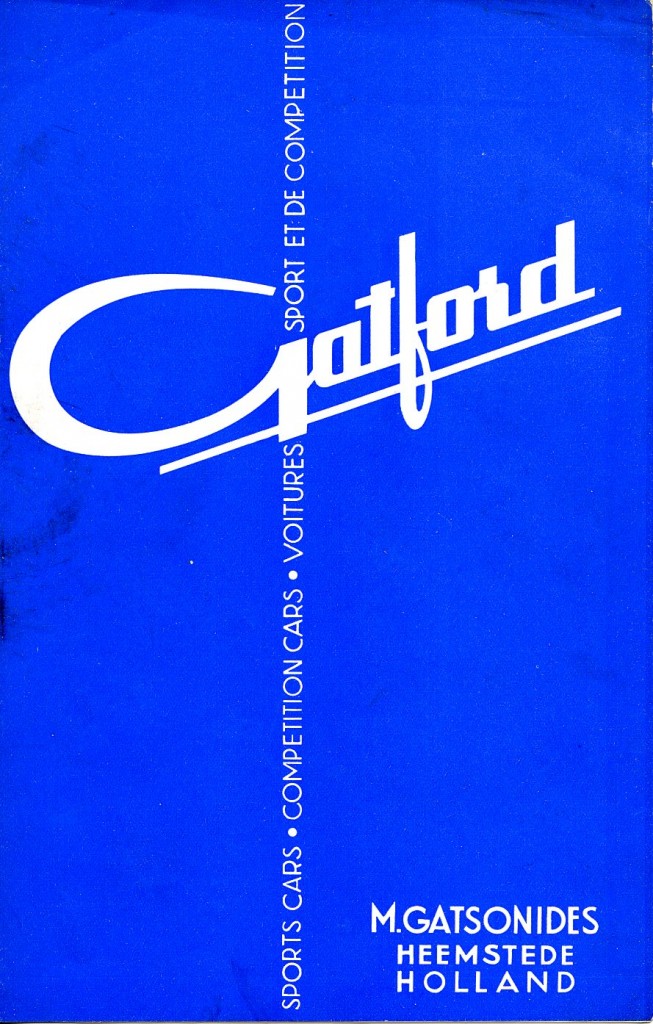

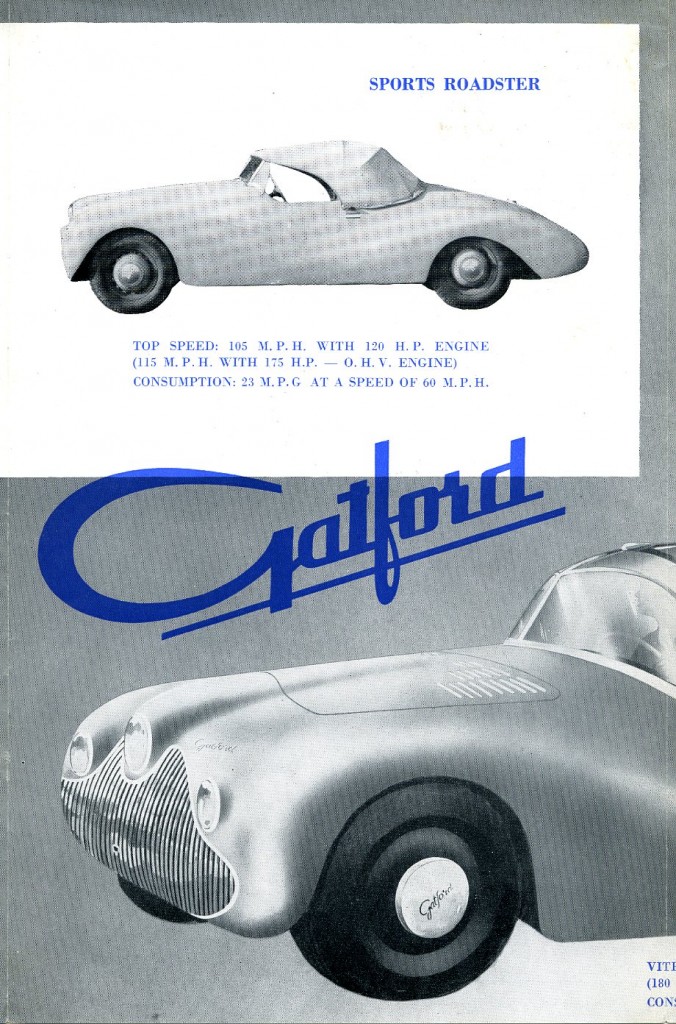
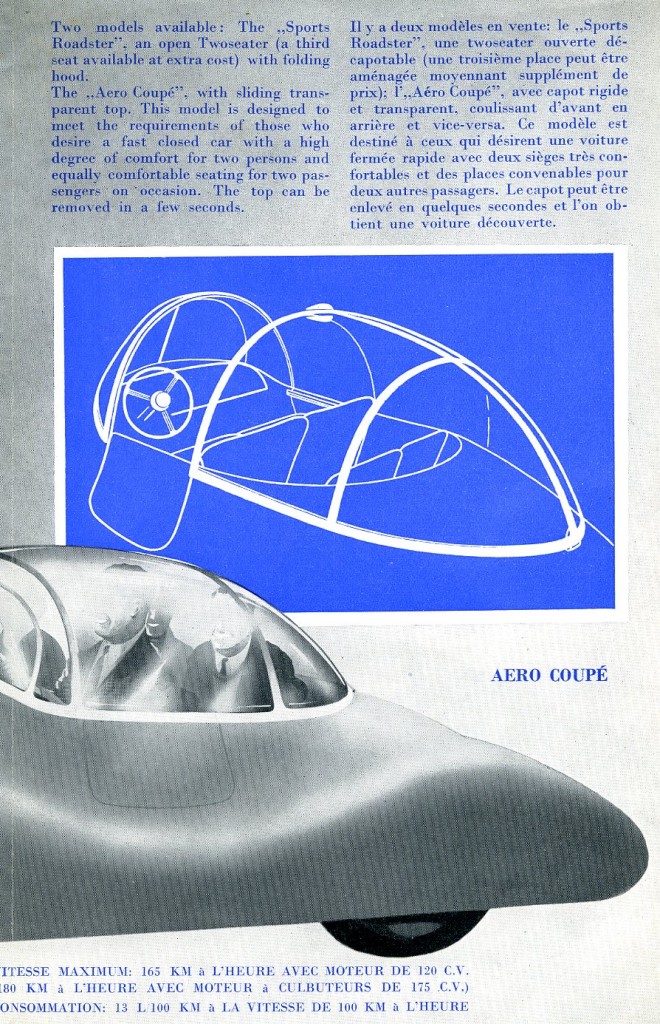
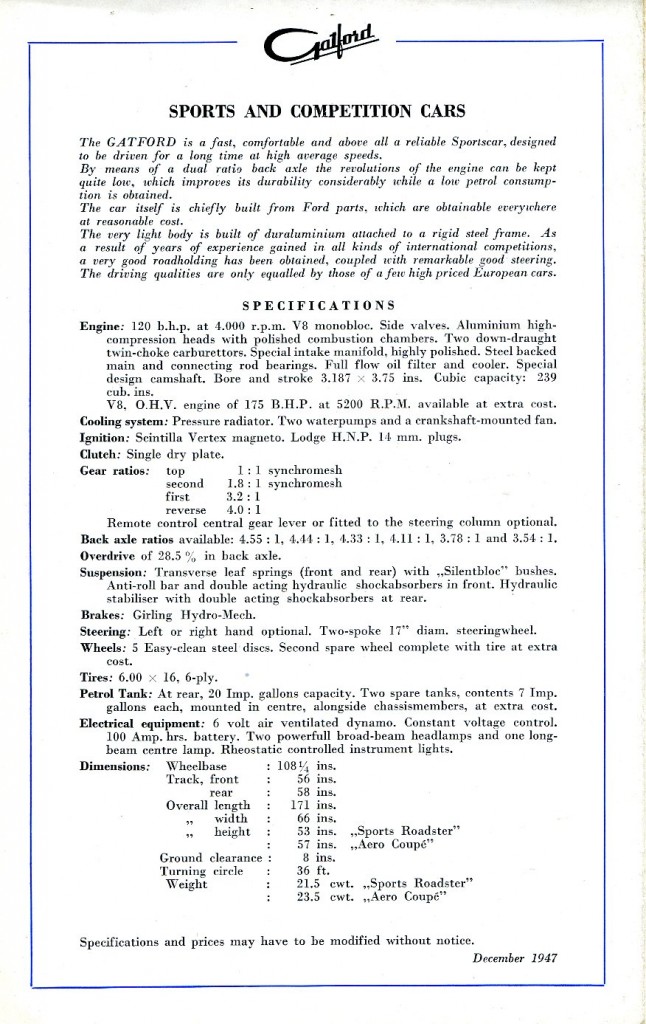







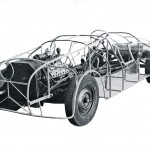
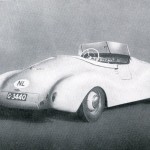
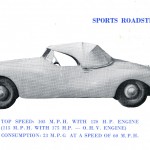
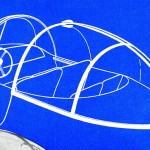
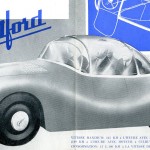

As a 14 year old living in Haarlem Holland I saw the first Gatsonides car being built in a small garage by an expert aluminum fabricator Mr.Harry Donders. His oldest son was my friend Tinus Donders Also my father was friends with Harry.
That was the first time I saw the use of an English wheel massaging the aluminum sheets to fit the frame for later welding.
One of the things that impressed me very much was the aircraft style canopy which was designed by Fokker aircraft factory.
All in all an awesome car. The Donders family emigrated to Australia. Our family emigrated to California USA in 1/1957.
Hi,
Yes I am Dutch and have met Maus Gatsonides personaly, 2 times. I have some books about him.
Like to hear more about the Gatso. Please!
Kindest regards
Paul Hooft
Paulhooft@ziggo.nl
Very nice article Geoff. Well done.
“VERY INTERESTING”.The tube frame built over the chassis would be a good way to build a mock-up for your next new car design..
Mel
Hi Jim…
There are 3 out there that have been found, and more waiting I’m sure. Just have to shake the trees across the world. Maybe we’ll find a couple of those elusive “teardrop” cars I love too
Geoff
Remarkably interesting cars, it is a shame so few were produced, certainly having one of these rare beauties would be a real show stopper in any collection. They were certainly competent as proved by the number of racing events that they won outright or placed very well in.
The 64K question what ever happened to them all?